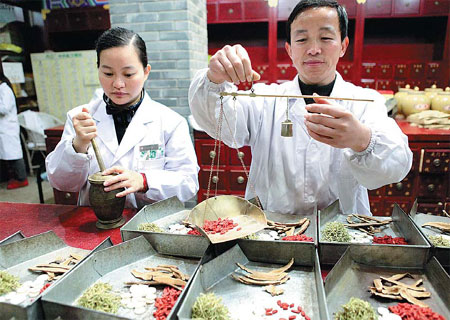IN BRIEF (Page 2)
Updated: 2013-03-29 08:30
(China Daily)
|
|||||||||||
|
Traditional Chinese medicine is facing an awkward situation at home while gaining popularity abroad. Liu Qinli / for China Daily |
Health
TCM makes waves globally
Though some Chinese scholars are seeking a ban on traditional Chinese medicine, foreign pharmaceutical companies and institutions are showing growing interest in it.
More than 100 countries and regions around the world have set up TCM institutions, with the US, Europe, Japan and South Korea investing heavily in related research and medication development.
The UK-based pharmaceutical company GlaxoSmithKline PLC announced its first TCM medication research and development program, which targets not just the Chinese market, but the global market, too.
"Our priority is to transform TCM from an experience-based practice to evidence-based medicines through innovation and differentiation," said Zang Jingwu, senior vice-president and head of GlaxoSmithKline's R&D division in China.
Policy
Import basket to be enlarged
As part of its efforts to boost domestic consumption, China will import commodities and services valued at around $10 trillion in the next five years. Disclosing this on March 25, Premier Li Keqiang said China was committed to attracting more investment in the services sector and in industries related to energy conservation and environmental protection.
In response to concerns expressed by multinational companies about the investment environment, Li said the government would work to create a level playing field for foreign companies vis-a-vis domestic competition, along with easier market access norms.
Li made the comments during a meeting with representatives and executive officers from about 100 multinational companies at the two-day China Development Forum in Beijing.
Society
Fight against poverty intensified
More funds will be allocated to lift China's rural dwellers out of poverty this year, along with an extra emphasis on making education more accessible to the poor, a poverty relief official said.
Though there is tremendous pressure due to the economic slowdown, poverty alleviation efforts should continue with renewed vigor, said Fan Xiaojian, director of the State Council's Poverty Alleviation Leading Group Office. The increase in funding this year is likely to surpass the growth last year.
In 2012, the government allocated 299.6 billion yuan ($48.2 billion; 37.54 billion euros) for poverty alleviation, an increase of about 32 percent compared with the previous year.
Over the past 12 months, China's rural population considered to be in poverty declined to about 99 million from 122 million - the first time the country has started to consider those with a yearly net income of less than 2,300 yuan as destitute.
Agriculture
Show blossoms into life
The First Beijing Agriculture Carnival kicked off in Changping district at the Strawberry Expo Garden in Xingshou township on March 23.
The carnival, which runs until May 12, highlights the latest technological advances and key projects. Visitors can see an array of produce in all shapes and sizes. Fruit and vegetables, including thumb-sized cucumbers, pumpkins weighing more than 50 kilograms, as well as produce grown in space, will be displayed.
Nearly 300 enterprises from home and abroad will attend the event, and up to 800,000 visitors are expected. The carnival is expected to bring about 400 million yuan in direct economic returns for the district.
Environment
Third Pole glaciers shrinking
About 90 percent of glaciers in the Third Pole region are shrinking, accelerated by black carbon being transferred from South Asia to the Tibetan Plateau, a scientist has warned.
The Third Pole region, which is centered on the Tibetan Plateau and concerns the interests of the surrounding countries and regions, covers more than 5 million square kilometers and has an average altitude of more than 4,000 meters.
The area has the largest number of glaciers outside the polar regions and is at the headwaters of many prominent Asian rivers.
Influenced by global warming, its alpine glaciers have seen drastic changes in recent years, such as thinning and shrinkage, which pose potential geological hazards to people both in and around the plateau.
Yao Tandong, director of the Chinese Academy of Sciences' Institute of Tibetan Plateau Research, says that some people believe the glaciers will retreat and finally disappear by 2030, while others argue they will remain unchanged.
(China Daily 03/29/2013 page2)
Today's Top News
List of approved GM food clarified
ID checks for express deliveries in Guangdong
Govt to expand elderly care
University asks freshmen to sign suicide disclaimer
Tibet gears up for new climbing season
Media asked to promote Sino-Indian ties
Shots fired at Washington Navy Yard
Minimum growth rate set at 7%
Hot Topics
Lunar probe , China growth forecasts, Emission rules get tougher, China seen through 'colored lens', International board,
Editor's Picks

|

|

|

|

|

|






